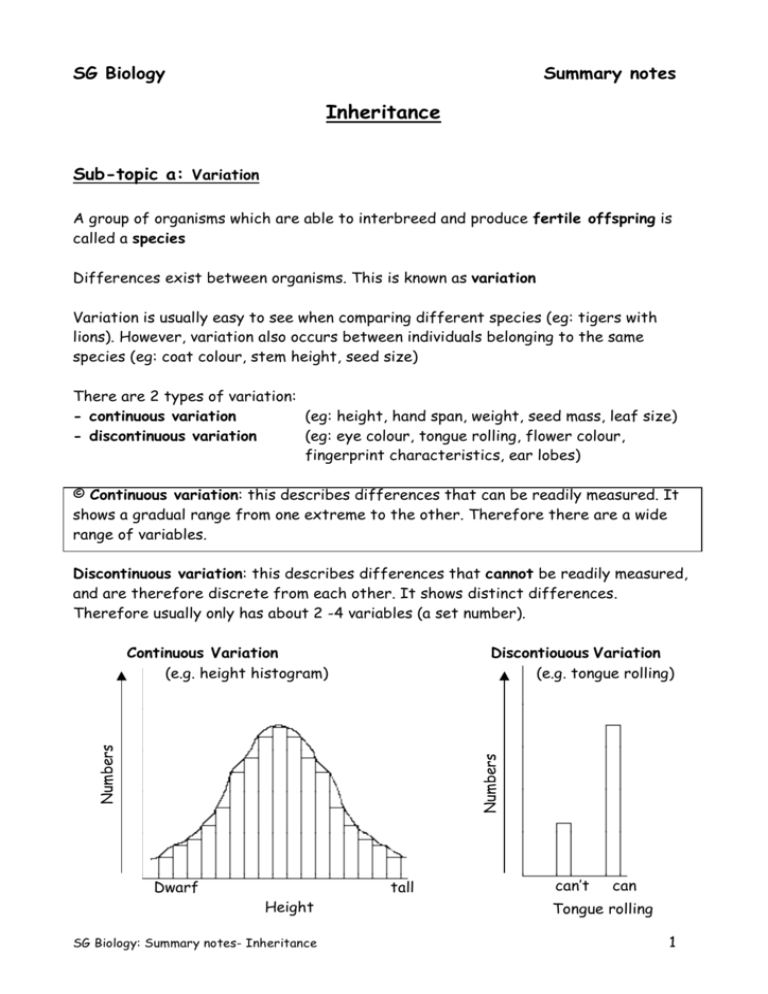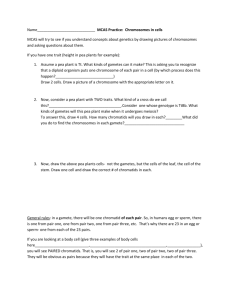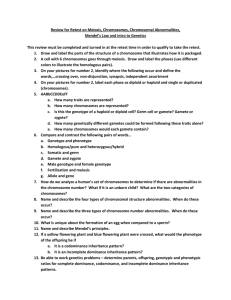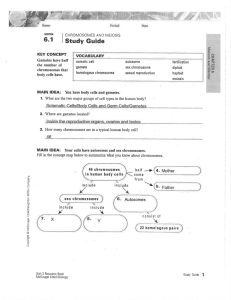6 inheritance summary
advertisement

SG Biology Summary notes Inheritance Sub-topic a: Variation A group of organisms which are able to interbreed and produce fertile offspring is called a species Differences exist between organisms. This is known as variation Variation is usually easy to see when comparing different species (eg: tigers with lions). However, variation also occurs between individuals belonging to the same species (eg: coat colour, stem height, seed size) There are 2 types of variation: - continuous variation (eg: height, hand span, weight, seed mass, leaf size) - discontinuous variation (eg: eye colour, tongue rolling, flower colour, fingerprint characteristics, ear lobes) © Continuous variation: this describes differences that can be readily measured. It shows a gradual range from one extreme to the other. Therefore there are a wide range of variables. Discontinuous variation: this describes differences that cannot be readily measured, and are therefore discrete from each other. It shows distinct differences. Therefore usually only has about 2 -4 variables (a set number). Discontiouous Variation (e.g. tongue rolling) Numbers Numbers Continuous Variation (e.g. height histogram) Dwarf tall Height SG Biology: Summary notes- Inheritance can’t can Tongue rolling 1 Sub-topic b: What is inheritance? All organisms produced through sexual reproduction will inherit characteristics from each parent. Animals can inherit characteristics such as size, hair colour, skin colour, sex. Plants can inherit characteristics such as flower colour, stem height, seed mass. Such characteristics may display several possible traits / versions (eg: hair colour may be brown, black or red). Each of these is called a phenotype for that characteristic. Words are used to describe phenotypes - the phenotypes for stem height in a plant may be tall or dwarf The phenotype depends on the information (genes) inherited from each parent. Genes represent the coded instructions necessary to control the development of organisms. The genes are carried on the chromosomes All the members of a species possess the same number of chromosomes (unless a mutation had occurred) There are 2 sets of chromosomes in every body cell; 1 set inherited from each parent Each characteristic is therefore controlled by 2 copies of each gene (1 from each parent) © The different versions of a gene are called alleles Special cells called gametes are produced for sexual reproduction. Animals produce ova and sperm, whilst plants produce ovules and pollen grains The cells which develop into gametes divide in a special way so that only 1 member of each pair of chromosomes goes into each gamete; each gamete therefore contains only 1 set of chromosomes (and therefore only 1 copy of each gene) When 2 gametes combine at fertilisation, the new cell (zygote) will now have 2 sets of chromosomes; and therefore 2 copies of each gene (the new individual can now begin its development) SG Biology: Summary notes- Inheritance 2 In some individuals the 2 copies of a gene will be the same, in others they may be different - if the 2 copies are the same, the individual is true-breeding for that characteristic. (© homozygous) - if the 2 copies are different, then that individual will not breed true for that characteristic. (© heterozygous) One of the copies may cancel out the effect of the other and can be said to be dominant, the one which is cancelled out is recessive. The description of the versions of a gene which are present for a particular characteristic is called a genotype (symbols/letters are used to describe genotypes) SG Biology: Summary notes- Inheritance 3 Inheritance of stem height in pea plants can be used to illustrate this. Letters used for this: T = tall, and t = dwarf -The genotype of a true-breeding tall plant would be shown as TT -The genotype of a true-breeding dwarf plant would be shown as tt © As only 1 characteristic is being studied, this is known as a monohybrid cross A cross between 2 plants, a true-breeding tall plant and a true-breeding dwarf plant would be shown as: Parents (P) Phenotype Parents (P) Genotype Gametes (G) Tall TT x x T First generation (F1) genotype First generation (F1) phenotype dwarf tt t all Tt all Tall (remember: each gamete can only receive 1 set of chromosomes and therefore only 1 of the symbols/letters) The tall version is dominant and so all the F1 will be tall. However, unlike their tall parent, they will not be true-breeding (like their tall parent) because they contain 2 different versions of the stem height gene A cross between 2 of the F1 generation (both are heterozygous) would be shown as: F1 Gametes (G) Tt x T and t F1 Gametes T t Second generation (F2) genotype Second generation (F2) phenotype Tt T and t T TT Tt t Tt tt 1 TT: 2 Tt: 1 tt 3 tall: 1 dwarf In the F2, because their parents were not true-breeding, 3 different genotypes can be produced: TT, Tt and tt -this results in 2 different phenotypes © The 2 phenotypes resulting from this type of cross are always in the ratio of approximately 3 dominant to 1 recessive; in this case 3 tall : 1 dwarf An exact ratio of 3 : 1 is hardly ever obtained in practice as not all of the gametes will have been fertilised, and not all of the resulting zygotes will develop. This is because fertilisation is a random process. SG Biology: Summary notes- Inheritance 4 The sex of an individual is controlled by special sex chromosomes -there are 2 types of sex chromosome: X and Y In humans 2 X chromosomes (XX) produce a female; whilst an X and a Y (XY) produce a male A female can therefore only produce gametes containing an X chromosome; whilst a male produces gametes containing an X chromosome, and gametes containing a Y chromosome. Humans have 46 chromosomes, 44 “normal” chromosomes plus 2 sex chromosomes. Male 44 + XY Female 44 + XX Sub topic c: genetics and society It is possible to select individuals from a species which possess a particularly useful characteristic (eg: fruit size, milk yield, growth rate etc:) with a view to breeding only from such plants or animals If several varieties are available it may be possible to cross breed. Any offspring which show an improvement in the characteristic/s being sought can be used for continued breeding. If this process is continued for several generations, the result will be organisms which will always produce offspring which show such improvement (true-breeding) - this process is called selective breeding. © All of our modern cereal crops (eg: rice, wheat, barley, oats) have been produced as a result of selective breeding. A variety of British wheat with soft grains was crossed with a Canadian variety with hard grains but low yield. A few of the plants produced had hard grains coupled with a high yield. These were then used for further breeding, and after about 12 years a variety of wheat had been bred which consistently gave a high yield and hard grains. Cattle have been selectively bred over many years to produce improved milk yields in dairy cows; and faster growth rates in beef cattle. SG Biology: Summary notes- Inheritance 5 Mutations Occasionally, part of a chromosome may become damaged or altered in some way. This is called a chromosome mutation. © Mutations will always occur naturally, but some agents (eg: radiation, such as UV light, X-rays, atomic radiation and certain chemicals such as mustard gas) increase the chances of mutations occurring. These agents are called mutagenic Down's syndrome in humans is an example of a condition caused by a chromosome mutation (an extra chromosome number 21; giving 3 of these chromosomes instead of just 2). Humans have 46 chromosomes in every cell, an individual with Down’s syndrome will have 47 chromosomes. It is possible to obtain some information about an embryo's chromosomes before it is born. The embryo is surrounded by amniotic fluid (in the amniotic sac) whilst it is in the uterus. As some of its cells become detached and float about in the fluid, taking a sample of this fluid will provide a sample of embryonic cells. This can be done by using a large syringe/needle, inserted through both the abdominal and uterine walls, to draw off some of the fluid; a process called amniocentesis. The cells obtained are then examined, and the chromosomes identified and counted to determine whether the embryo has Down's syndrome (or various other inherited disorders). It is also possible to tell if the embryo is male or female. © Most mutations are harmful but some mutations produce changes which are useful to man; such as larger fruits or increased resistance to disease in plants, or faster growing breeds of domestic livestock. SG Biology: Summary notes- Inheritance 6








